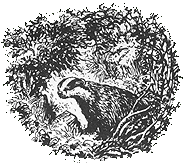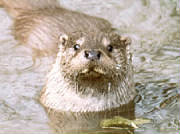|
Badgers, Bats, Barn Owls and Others

|
| Illustration: Hans Helweg |
The Combe
The Combe was ever dark, ancient and dark.
Its mouth is stopped with bramble, thorn, and briar;
And
no one scrambles over the sliding chalk
By beech and yew and perishing juniper
Down the half precipices of its sides,
with roots
And rabbit holes for steps. The sun of Winter,
And moon of Summer, and all the singing birds
Except the
missel-thrush that loves juniper,
Are quite shut out. But far more ancient and dark
The Combe looks since they killed
the badger there,
Dug him out and gave him to the hounds,
That most ancient Briton of English beasts.
Edward Thomas
The culling of badgers
We must learn to live with nature and not to fight it or to use it as a scapegoat for
our inadequacies and malpractices. The problem of bovine TB surely stems from the intensification of agriculture and uncontrolled
movement of cattle all around the country (13 million movements in Britain in 2004) which helps to spread the disease. Bovine
TB claimed 599 cattle in 1986, by 2004 this had risen to 22,570. As Andreas Whittam Smith pointed out in "Why I have changed
my mind about badgers" in The Independent on 19 December, bTB is just one of the reasons why cattle are killed prematurely.
Each year 90,000 are put down because of mastitis, 125,000 because they are infertile and 31,000 because they are lame –
and this has nothing to do with badgers. Surely this is unacceptable on animal welfare grounds alone? What kind of life do
these animals lead? With the price of milk so low, it is obvious that dairy farmers try to get the highest yields possible
from their cows. Defra should be helping the dairy industry clean up its act and spend the huge amounts of money that would
be spent on mass badger culls on grant aiding dairy farmers to change their practises. Cheap food cheapens out attitudes to
animals, to nature. Let us pay more for our milk and be assured that the quality of life for farm animals and farmers improves.
Despite years of testing, it has not been scientifically proven that badgers are the
culprit. Many believe that cattle are infecting badgers.
Otters

Otters are a secretive semi-aquatic species which was once widespread in Britain. Today,
they are restricted mainly to Scotland, parts of East Anglia and the West Country.
Otters are generally nocturnal animals. They have brown fur, a long slender body (60-120
cm), small ears, a long thick tail and webbed feet. The average weight for a male is 10.1kg
Habitat
Otters live along rivers, lakes and sea coasts, and, also, in marshy areas away from open
water. Fish are the otter's most important food. Otters may also take water birds and in the spring, frogs are an important
food item. Some are known to use 20km or more of river habitat.
Otters require clean rivers with an abundant, varied supply of food and plenty of bankside
vegetation offering secluded sites for their holts.
In England and Wales otter cubs, usually in litters of two or three, can be born at any
time of the year.
In Shetland and North-west Scotland most births occur in summer.
Cubs are normally born in dens, called holts. The mother raises the cubs without help from
the male. Initially females catch food for their cubs, which remain with her for about a year.
Reintroduction
In the late 1950s and early 1960s, otters underwent a sudden and catastrophic decline throughout much
of Britain and Europe, thought to be due to the combined effect of pollution and habitat destruction.
Attempts have been made to bring otters back to their former haunts, by reintroducing captive
bred and rehabilitated animals to the wild. These reintroductions are not easy, but have been very successful is some cases.
There is evidence that in certain parts of the UK the otter is extending its range and may
be increasing locally. However, populations in England are very fragmented and the animals breed only slowly.
Otters are strictly protected by the Wildlife and Countryside Act (1981) and cannot be killed, kept or sold except under licence.
Otters can live to be ten years old, though few survive more than five years
Ecology of key species :
American Mink, Badger, Brown Hare, Red Deer, Red Fox, Otter
|
 |
|
 |
 |
|
|
|
here's what happened
on Friday 5th August
at .......well we'll let the
website explain and get
themselves off the hook
a view from Tweenies
at CBeebies
at the BBC
a limited company
(number 5460677)
and a registered charity
(number 1111440) which
promotes the conservation
and welfare of badgers and
the protection of their setts
and
habitats.
conserving the barn owl
and its environment
there are 17 species of bat
in the UK, all of which are
protected by law because
their numbers have decreased
so dramatically.
September 2005 saw the
launch of the UK’s largest
landscape scale rare bat
survey, for which the
National Trust is a partner.
taking place in Purbeck, Dorset,
the Purbeck Bat Project will,
over the next three years, carry
out research on the greater
horseshoe bat and other
bats in the Purbeck area.
some details about
those bat species
and where you can
find them, or where
they can find you
|
|
 |
 |

|
 |
 |
 |
|
|
 |
 |
 |
|
|
|

